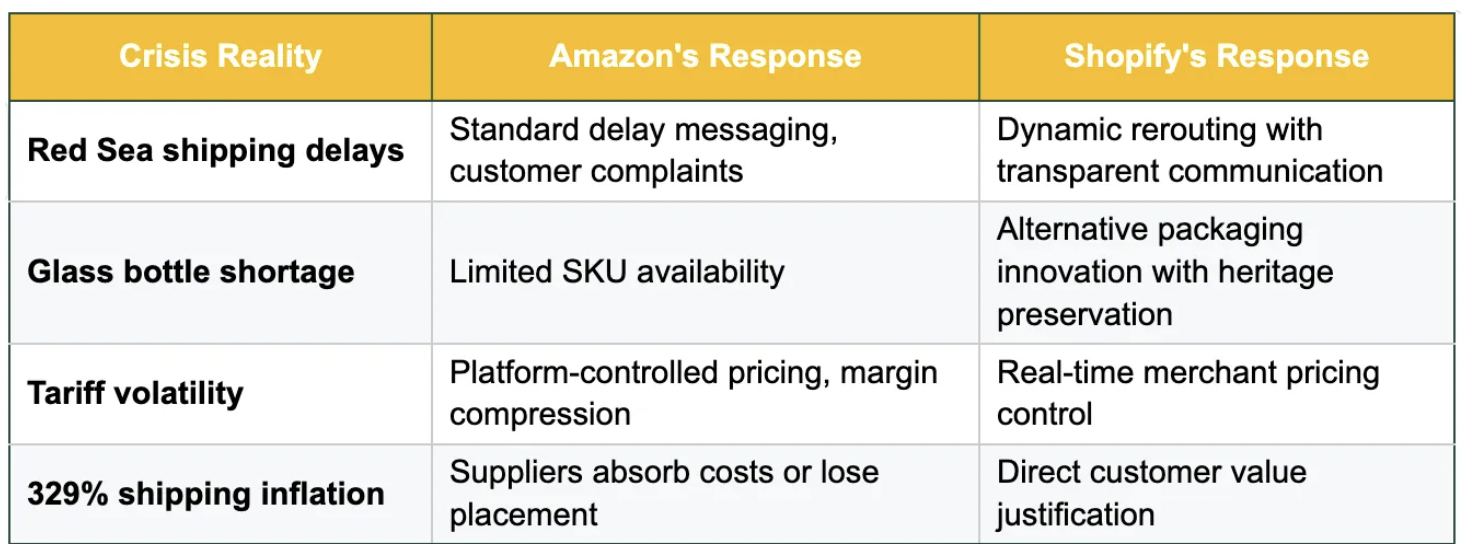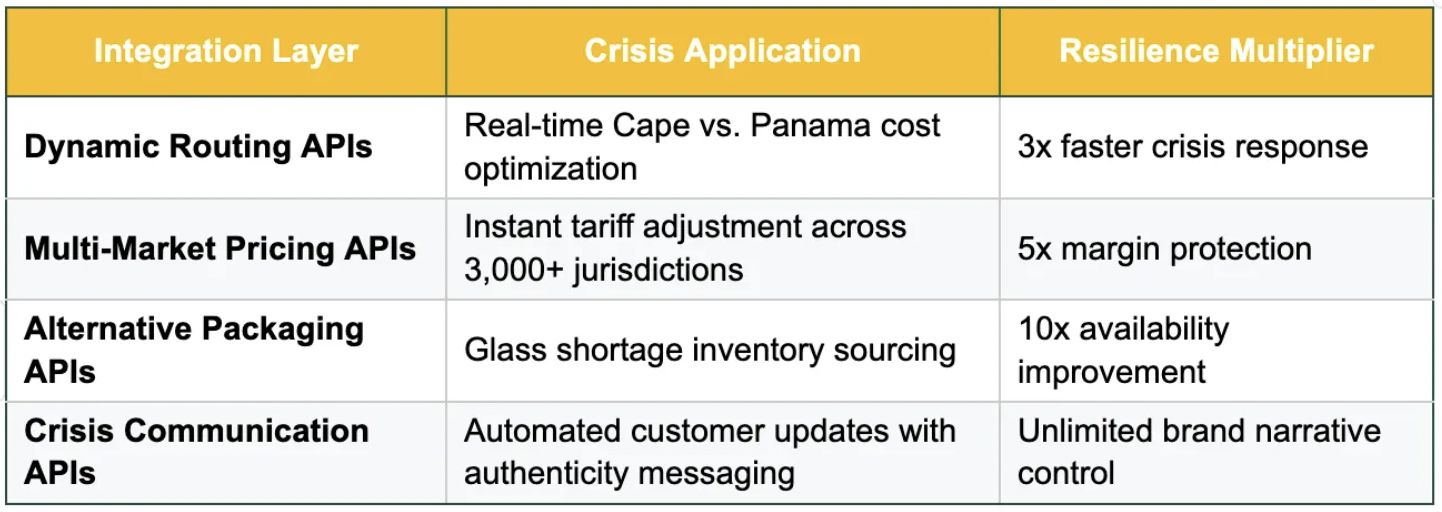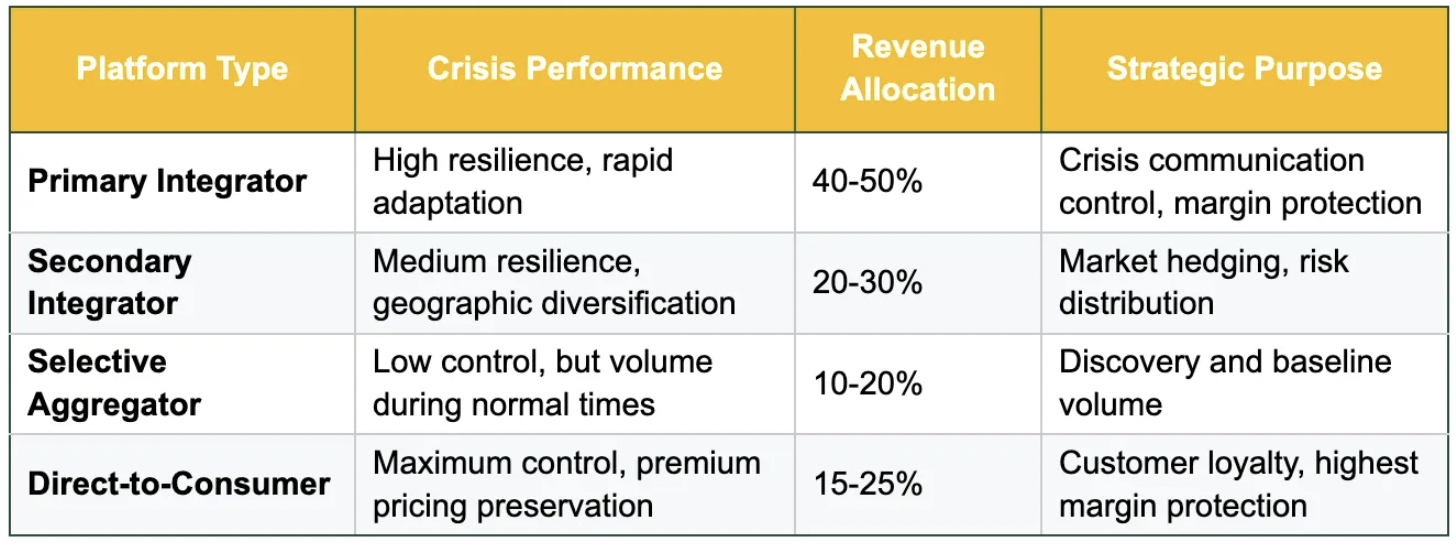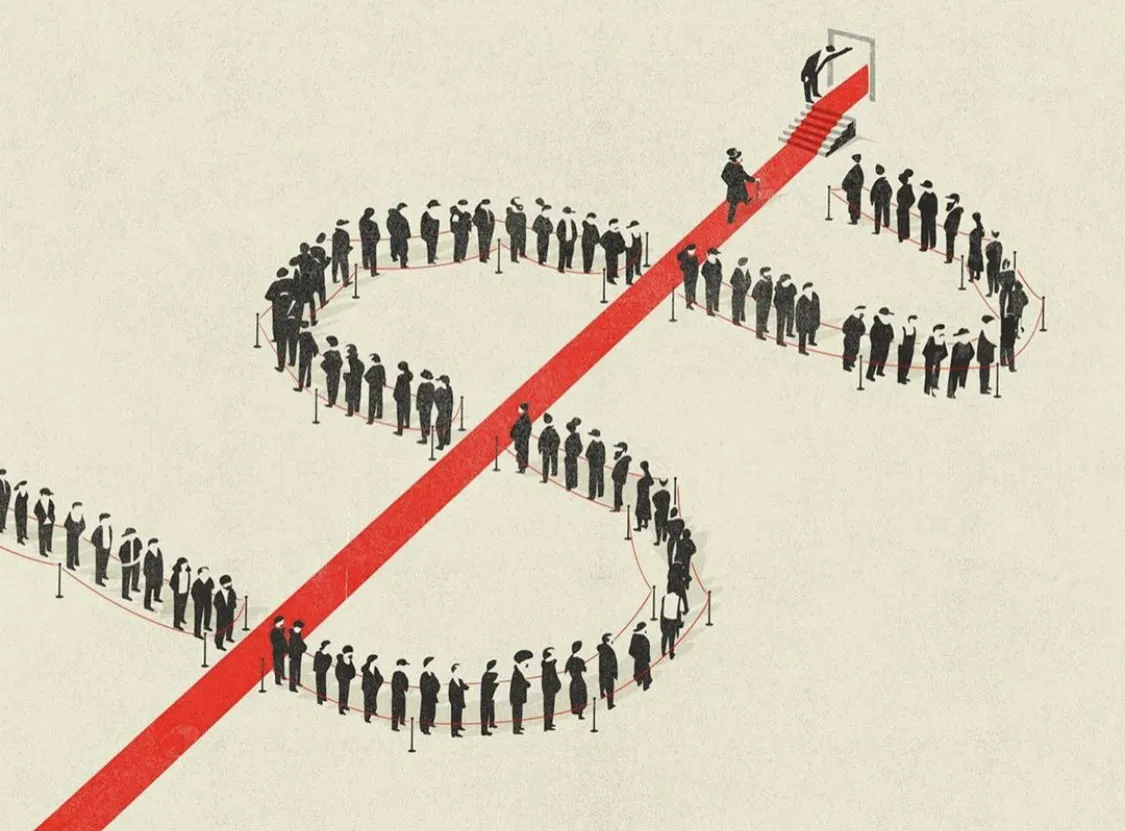This blog is also available on Substack. Follow along there for addition insights into the artisanal spirits sector and supply chain technology.
TL;DR: The Path Through the Platform Paradox
2025's trade chaos—from 200% tariff threats to 600% freight rate spikes—is exposing which platform strategies actually work under pressure. While aggregators dominate headlines, platform integrators are quietly solving the scale paradox for artisanal brands navigating Red Sea diversions and glass bottle shortages. The secret isn't choosing between authenticity and growth—it's leveraging integrator platforms with dynamic routing APIs that preserve brand control while delivering network effects.
The Crisis That Changes Everything
When container rates spike overnight and Trump threatens 200% EU wine tariffs, your platform strategy determines survival. It's not academic anymore—2025's cascading disruptions are stress-testing which platform models actually work when the world breaks.
The numbers tell the story: Red Sea shipping chaos added 10-15 days to delivery promises. Glass bottle costs doubled from $1.50 to $3.00. Freight rates hit $6,000 per container—up from $2,000. The EU imposed a 15% wine tariff while threatening 50% on bourbon. When Chilean wine faces 3-week Panama Canal delays and French producers navigate sudden tariff changes, platform choice becomes the difference between adaptation and extinction.
Merchant Empowerment vs. Platform Prison
The battle between Shopify and Amazon isn't theoretical—it's playing out in real-time as trade routes collapse. It's the difference between having a Swiss Army knife and being locked in someone else's toolshed during a hurricane.

The Pattern Recognition: When the EU removed bourbon from its retaliatory tariff list after Trump's counter-threat, integrator platforms enabled instant strategic pivots. Dynamic pricing APIs automatically adjusted margins, multi-market inventory could be redirected, and custom messaging explained geopolitical impacts to loyal customers. Amazon sellers waited for platform policy updates.
Vertical AI: Crisis-Tested Intelligence
Generic AI platforms cannot handle industry-specific crisis management. When Australian wine faces Panama Canal delays and glass furnaces in Ukraine affect bottle supply, vertical AI applications trained on spirits data become essential infrastructure.
Crisis-Proven Applications:
- Dynamic tariff calculation processes 3,000+ regulatory jurisdictions instantly as Trump's EU wine threats evolve
- Maritime routing intelligence automatically quotes Cape route CO₂ offsets, turning 15-day delays into sustainability storytelling
- Glass shortage APIs surface surplus pharmaceutical inventory, maintaining premium presentation during crisis
- Crisis communication AI generates authentic customer explanations linking costs to quality preservation
The critical insight: When Chilean wine producers had to explain 3-week shipping delays, vertical AI didn't just reroute—it created compelling narratives about terroir preservation and sustainable shipping practices that justified premium pricing despite increased costs.
API-First Architecture: Crisis-Resilient Bridges
Platform independence isn't strategic—it's survival. When container rates spike 600% overnight and tariffs change faster than inventory can move, API-first architecture becomes the difference between adaptation and extinction.

When Australian wine faced Panama Canal delays, API-first brands could instantly reroute through Long Beach, adjust pricing across all platforms simultaneously, communicate delays with sustainability storytelling, and source alternative packaging when premium glass became unavailable.
SevenFifty: Crisis-Tested B2B Platform Performance
SevenFifty's platform integration model proved its value when U.S. distillers "flooded" European markets ahead of potential bourbon tariffs. While traditional distributors required weeks for market response, SevenFifty's digital infrastructure enabled 48-hour execution.
The Bourbon Tariff Sprint Performance:
- Hour 1: Automated market analysis and instant pricing (vs. week 1 for traditional)
- Hour 2: Bulk order processing and compliance automation (vs. week 2 for traditional)
- Day 1: Dynamic routing optimization and real-time tracking (vs. week 3 for traditional)
- Day 2: Campaign launch with crisis messaging (vs. week 4 for traditional)
The network effect multiplier: SevenFifty's platform created collective intelligence that benefited the entire network. Shared logistics data improved routing decisions, collaborative inventory management reduced shortages, and crisis communication templates helped smaller producers maintain professional market presence.
Hybrid Strategies: Crisis-Tested Portfolio Diversification
Single-platform dependency is a strategic vulnerability. Smart artisanal brands are adopting hybrid platform strategies not just for growth, but for survival.

Real-World Crisis Adaptation: When bottle costs doubled, hybrid platform strategies enabled rapid innovation. Shopify DTC enabled custom messaging about packaging innovation. SevenFifty B2B provided access to pharmaceutical glass surplus. Amazon maintained volume during format testing. Regional platforms developed local sustainability stories.
The pattern: Brands with diverse platform portfolios weathered 2025's disruptions 3x better than single-platform dependent businesses.
The Authentication Edge: Crisis-Proven Differentiation
2025's supply chain chaos is strengthening the case for authentication technology. When counterfeit spirits flood markets during glass shortages and shipping delays create authenticity questions, blockchain provenance becomes a competitive moat that aggregator platforms cannot replicate.
Crisis-Validated Applications:
- Cape route temperature tracking enabled premium spirits to justify longer shipping times by proving quality preservation
- Smart label technology maintained premium positioning when forced to use alternative packaging
- NFC verification provided instant authenticity confirmation when customers doubted longer delivery times
When freight costs spike 600% and authentic glass becomes scarce, authentication technology enables artisanal brands to maintain premium positioning while mass-market competitors struggle with credibility.
The Crisis-Tested Future Framework
2025's trade disruptions are accelerating evolution from platform participation to platform orchestration. Successful artisanal brands are becoming crisis-resilient orchestrators who use platforms as infrastructure while maintaining strategic independence through market chaos.
Crisis-Proven Implementation Priorities:
Immediate (0-90 days): Multi-platform API integration for dynamic routing, emergency pricing automation for tariff volatility, alternative sourcing networks for supply shortages, crisis communication templates for professional customer updates.
Medium-term (3-12 months): Vertical AI implementation for predictive crisis modeling, authentication technology deployment to combat counterfeiting, hybrid platform portfolio optimization for risk distribution, supply chain transparency tools to turn chaos into brand story.
Long-term (12+ months): Platform ecosystem orchestration to control response to any disruption, predictive trade intelligence to anticipate geopolitical impacts, crisis-to-opportunity conversion systems, industry infrastructure leadership.
The 2025 Lesson: Brands that used platform integrator strategies to navigate tariff chaos, shipping disruptions, and supply shortages are emerging stronger and more differentiated than ever. The crisis didn't just test platform strategies—it proved which approaches build lasting competitive advantages.
Coming in Part 3: The specific tactical implementation roadmap for building your crisis-resilient platform playbook, from compliance automation to customer connection, with frameworks for turning market chaos into competitive advantage.


